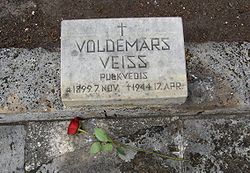
Voldemars Veiss
Encyclopedia

Lieutenant colonel
Lieutenant colonel is a rank of commissioned officer in the armies and most marine forces and some air forces of the world, typically ranking above a major and below a colonel. The rank of lieutenant colonel is often shortened to simply "colonel" in conversation and in unofficial correspondence...
in the Latvian Army and a prominent Nazi collaborator, Standartenführer
Standartenführer
Standartenführer was a Nazi Party paramilitary rank that was used in the so-called Nazi combat-organisations: SA, SS, NSKK and the NSFK...
(Colonel) in the German Waffen-SS.
When Riga
Riga
Riga is the capital and largest city of Latvia. With 702,891 inhabitants Riga is the largest city of the Baltic states, one of the largest cities in Northern Europe and home to more than one third of Latvia's population. The city is an important seaport and a major industrial, commercial,...
, the capital of Latvia
Latvia
Latvia , officially the Republic of Latvia , is a country in the Baltic region of Northern Europe. It is bordered to the north by Estonia , to the south by Lithuania , to the east by the Russian Federation , to the southeast by Belarus and shares maritime borders to the west with Sweden...
fell to the Germans on July 1, 1941, the Germans began forming self defence and police forces. Lieutenant Colonel Voldemārs Veiss was appointed the commander of such a Self Defence organization. Veiss broadcast a radio call for volunteers to enlist and rid Latvia of "traitors", including Soviet functionaries, communists and Jews. Many enlisted, and the "cleansing" started.
On July 20 the Nazis disbanded this organization and ordered the formation of auxiliary police
Auxiliary police
Auxiliary police or special constables in England) are usually the part-time reserves of a regular police force. They may be armed or unarmed. They may be unpaid volunteers or paid members of the police service with which they are affiliated...
forces instead, with Lt. Col. Veiss being appointed Chief of the Auxiliary Police. At the end of 1941, he became First Deputy Director General of the Director General of the Interior when the Latvian Self-Administration was reorganized.
As early as autumn 1941 Latvian auxiliary police units, temporarily attached to the Wehrmacht
Wehrmacht
The Wehrmacht – from , to defend and , the might/power) were the unified armed forces of Nazi Germany from 1935 to 1945. It consisted of the Heer , the Kriegsmarine and the Luftwaffe .-Origin and use of the term:...
, were first used in front line duties. This occasional employment continued until the 2nd Latvian Brigade was formed from six Latvian battalions, four of which had combat experience. At the end of April 1943 a three battalion formation fighting under name of Latvian Legion was withdrawn from the front line and renamed 1st Volunteer Regiment of the SS (Latvian), with a change of Wehrmacht ranks to those of Waffen-SS
Waffen-SS
The Waffen-SS was a multi-ethnic and multi-national military force of the Third Reich. It constituted the armed wing of the Schutzstaffel or SS, an organ of the Nazi Party. The Waffen-SS saw action throughout World War II and grew from three regiments to over 38 divisions, and served alongside...
. Voldemārs Veiss was given command of this regiment, which was a part of the 2nd Latvian Brigade, and received a rank of Legion-Obersturmbannführer
Obersturmbannführer
Obersturmbannführer was a paramilitary Nazi Party rank used by both the SA and the SS. It was created in May 1933 to fill the need for an additional field grade officer rank above Sturmbannführer as the SA expanded. It became an SS rank at the same time...
.
In September 1943, during the Siege of Leningrad
Siege of Leningrad
The Siege of Leningrad, also known as the Leningrad Blockade was a prolonged military operation resulting from the failure of the German Army Group North to capture Leningrad, now known as Saint Petersburg, in the Eastern Front theatre of World War II. It started on 8 September 1941, when the last...
, Veiss earned an Iron Cross 1st Class
Iron Cross
The Iron Cross is a cross symbol typically in black with a white or silver outline that originated after 1219 when the Kingdom of Jerusalem granted the Teutonic Order the right to combine the Teutonic Black Cross placed above a silver Cross of Jerusalem....
for his actions during the Battle of Spaskaya Polist and in October he was promoted to Legion-Standartenführer and appointed Infantry Leader of the brigade. In January 1944 Veiss led a battle group (Kampfgruppe
Kampfgruppe
In military history and military slang, the German term Kampfgruppe can refer to a combat formation of any kind, but most usually to that employed by the German Wehrmacht and its allies during World War II and, to a lesser extent, in World War I...
) bearing his name and for his defence of Nekokhovo and personal valour he became the first Latvian to receive the Knight's Cross
Knight's Cross of the Iron Cross
The Knight's Cross of the Iron Cross was a grade of the 1939 version of the 1813 created Iron Cross . The Knight's Cross of the Iron Cross was the highest award of Germany to recognize extreme battlefield bravery or successful military leadership during World War II...
.
When the 2nd Latvian Brigade became the 19th Waffen Grenadier Division of the SS (2nd Latvian)
19th Waffen Grenadier Division of the SS (2nd Latvian)
The 19th Waffen Grenadier Division of the SS was an Infantry Division of the Waffen SS during World War II. It was the second Latvian division formed in January 1944, after its sister unit, the 15th Waffen Grenadier Division of the SS...
he continued as the Infantry Leader of this unit. On April 17, 1944 Veiss died after having been wounded by a grenade seven days earlier.
In March 1945 the 42nd Waffen Grenadier Regiment of the SS (1st Latvian) was named in his honour.

